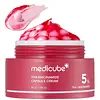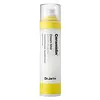What's inside
What's inside
 Key Ingredients
Key Ingredients

 Benefits
Benefits

 Concerns
Concerns

 Ingredients Side-by-side
Ingredients Side-by-side

Water
Skin ConditioningGlycerin
HumectantNiacinamide
SmoothingMethylpropanediol
SolventPropanediol
Solvent1,2-Hexanediol
Skin ConditioningDipropylene Glycol
HumectantCaprylic/Capric Triglyceride
MaskingGlyceryl Glucoside
HumectantButylene Glycol
HumectantArginine
MaskingEthylhexyl Palmitate
EmollientCarbomer
Emulsion StabilisingCetearyl Alcohol
EmollientCetearyl Olivate
Sorbitan Olivate
EmulsifyingC12-14 Alketh-12
EmulsifyingAmmonium Acryloyldimethyltaurate/Vp Copolymer
Simethicone
EmollientEthylhexylglycerin
Skin ConditioningMelia Azadirachta Flower Extract
Skin ConditioningMelia Azadirachta Leaf Extract
Skin ConditioningAdenosine
Skin ConditioningPolyacrylate-13
Disodium EDTA
Cyanocobalamin
Skin ConditioningTriethyl Citrate
MaskingBetaine
HumectantPolyisobutene
Glyceryl Stearate
EmollientHydrolyzed Sclerotium Gum
HumectantTranexamic Acid
AstringentAbelmoschus Esculentus Fruit Extract
Skin ConditioningPanthenol
Skin ConditioningCoccinia Indica Fruit Extract
Skin ConditioningCorallina Officinalis Extract
Skin ConditioningPolysorbate 20
EmulsifyingSorbitan Isostearate
EmulsifyingGlutathione
Fragaria Vesca Fruit Extract
AstringentCastanea Crenata Shell Extract
Skin ConditioningCitrus Junos Peel Extract
Skin ConditioningBetula Platyphylla Japonica Bark
Skin ConditioningRicinus Communis Seed Oil
MaskingBisabolol
MaskingFerulic Acid
AntimicrobialCymbopogon Citratus Leaf Oil
MaskingIllicium Verum Fruit/Seed Oil
MaskingOctyldodecanol
EmollientHydrolyzed Hyaluronic Acid
Humectant3-O-Ethyl Ascorbic Acid
Skin ConditioningSodium Hyaluronate
HumectantAlpha-Arbutin
AntioxidantHydrogenated Lecithin
EmulsifyingCeramide NP
Skin ConditioningHydroxypropyltrimonium Hyaluronate
Caprylyl Glycol
EmollientSodium Acetylated Hyaluronate
HumectantHyaluronic Acid
HumectantSodium Hyaluronate Crosspolymer
HumectantHydrolyzed Sodium Hyaluronate
Skin ConditioningPotassium Hyaluronate
Skin ConditioningWater, Glycerin, Niacinamide, Methylpropanediol, Propanediol, 1,2-Hexanediol, Dipropylene Glycol, Caprylic/Capric Triglyceride, Glyceryl Glucoside, Butylene Glycol, Arginine, Ethylhexyl Palmitate, Carbomer, Cetearyl Alcohol, Cetearyl Olivate, Sorbitan Olivate, C12-14 Alketh-12, Ammonium Acryloyldimethyltaurate/Vp Copolymer, Simethicone, Ethylhexylglycerin, Melia Azadirachta Flower Extract, Melia Azadirachta Leaf Extract, Adenosine, Polyacrylate-13, Disodium EDTA, Cyanocobalamin, Triethyl Citrate, Betaine, Polyisobutene, Glyceryl Stearate, Hydrolyzed Sclerotium Gum, Tranexamic Acid, Abelmoschus Esculentus Fruit Extract, Panthenol, Coccinia Indica Fruit Extract, Corallina Officinalis Extract, Polysorbate 20, Sorbitan Isostearate, Glutathione, Fragaria Vesca Fruit Extract, Castanea Crenata Shell Extract, Citrus Junos Peel Extract, Betula Platyphylla Japonica Bark, Ricinus Communis Seed Oil, Bisabolol, Ferulic Acid, Cymbopogon Citratus Leaf Oil, Illicium Verum Fruit/Seed Oil, Octyldodecanol, Hydrolyzed Hyaluronic Acid, 3-O-Ethyl Ascorbic Acid, Sodium Hyaluronate, Alpha-Arbutin, Hydrogenated Lecithin, Ceramide NP, Hydroxypropyltrimonium Hyaluronate, Caprylyl Glycol, Sodium Acetylated Hyaluronate, Hyaluronic Acid, Sodium Hyaluronate Crosspolymer, Hydrolyzed Sodium Hyaluronate, Potassium Hyaluronate
Water
Skin ConditioningTriethylhexanoin
MaskingHydrogenated Poly(C6-14 Olefin)
EmollientMethylpropanediol
SolventDipropylene Glycol
Humectant1,2-Hexanediol
Skin ConditioningHydrogenated Lecithin
EmulsifyingButylene Glycol
HumectantTrehalose
HumectantCellulose Gum
Emulsion StabilisingEthylhexylglycerin
Skin ConditioningPolyglyceryl-10 Myristate
Skin ConditioningXylitylglucoside
HumectantElaeis Guineensis Oil
EmollientAnhydroxylitol
HumectantCitrus Aurantium Bergamia Fruit Oil
MaskingPelargonium Graveolens Flower Oil
MaskingXylitol
HumectantCeramide NP
Skin ConditioningUlmus Davidiana Root Extract
Skin ConditioningAmaranthus Caudatus Seed Extract
Skin ConditioningSucrose Distearate
EmollientGlucose
HumectantSalvia Officinalis Oil
MaskingGlyceryl Stearate
EmollientHamamelis Virginiana Extract
AntiseborrhoeicPogostemon Cablin Leaf Oil
MaskingRhodiola Sachalinensis Extract
Skin ConditioningCeramide As
Skin ConditioningCholesterol
EmollientCeramide Ns
Skin ConditioningCeramide AP
Skin ConditioningWater, Triethylhexanoin, Hydrogenated Poly(C6-14 Olefin), Methylpropanediol, Dipropylene Glycol, 1,2-Hexanediol, Hydrogenated Lecithin, Butylene Glycol, Trehalose, Cellulose Gum, Ethylhexylglycerin, Polyglyceryl-10 Myristate, Xylitylglucoside, Elaeis Guineensis Oil, Anhydroxylitol, Citrus Aurantium Bergamia Fruit Oil, Pelargonium Graveolens Flower Oil, Xylitol, Ceramide NP, Ulmus Davidiana Root Extract, Amaranthus Caudatus Seed Extract, Sucrose Distearate, Glucose, Salvia Officinalis Oil, Glyceryl Stearate, Hamamelis Virginiana Extract, Pogostemon Cablin Leaf Oil, Rhodiola Sachalinensis Extract, Ceramide As, Cholesterol, Ceramide Ns, Ceramide AP
 Reviews
Reviews

Ingredients Explained
These ingredients are found in both products.
Ingredients higher up in an ingredient list are typically present in a larger amount.
1,2-Hexanediol is a synthetic liquid and another multi-functional powerhouse.
It is a:
- Humectant, drawing moisture into the skin
- Emollient, helping to soften skin
- Solvent, dispersing and stabilizing formulas
- Preservative booster, enhancing the antimicrobial activity of other preservatives
Butylene Glycol (or BG) is used within cosmetic products for a few different reasons:
Overall, Butylene Glycol is a safe and well-rounded ingredient that works well with other ingredients.
Though this ingredient works well with most skin types, some people with sensitive skin may experience a reaction such as allergic rashes, closed comedones, or itchiness.
Learn more about Butylene GlycolCeramide NP is a type of ceramide.
Ceramides are intercellular lipids naturally found in our skin that bonds dead skin cells together to create a barrier. They are known for their ability to hold water and thus are a great ingredient for dry skin.
Ceramides are an important building block for our skin barrier. A stronger barrier helps the skin look more firm and hydrated. By bolstering the skin ceramides act as a barrier against irritating ingredients. This can help with inflammation as well.
If you would like to eat ceramides, sweet potatoes contain a small amount.
Read more about other common types of ceramides here:
Ceramide AP
Ceramide EOP
Dipropylene Glycol is a synthetically created humectant, stabilizer, and solvent.
This ingredient helps:
Dipropylene glycol is technically an alcohol, but it belongs to the glycol family (often considered part of the ‘good’ alcohols). This means it is hydrating and gentle on skin unlike drying solvent alcohols like denatured alcohol.
As a masking agent, Dipropylene Glycol can be used to cover the smell of other ingredients. However, it does not have a scent.
Studies show Dipropylene Glycol is considered safe to use in skincare.
Learn more about Dipropylene GlycolEthylhexylglycerin (we can't pronounce this either) is commonly used as a preservative and skin softener. It is derived from glyceryl.
You might see Ethylhexylglycerin often paired with other preservatives such as phenoxyethanol. Ethylhexylglycerin has been found to increase the effectiveness of these other preservatives.
Glyceryl Stearate is a mix of glycerin and stearic acid.
It is used to stabilize the mixing of water and oil ingredients. By preventing these ingredients from separating, it can help elongate shelf life. It can also help thicken the product's texture.
As an emollient, it helps soften skin and supports barrier-replenishing ingredients.
In cosmetics, Glyceryl Stearate is often made from vegetable oils or synthetically produced.
This ingredient may not be fungal-acne safe
Fun fact: The human body also creates Glyceryl Stearate naturally.
Learn more about Glyceryl StearateHydrogenated Lecithin is created from the hydrogenation of lecithin (a group of phospholipids). Hydrogenation is a chemical reaction between hydrogen and another element.
This ingredient is an emollient and emulsifier. As an emollient, it helps soften skin by trapping moisture within. As an emulsifier, it prevents oil and water ingredients from separating.
Methylpropanediol is a synthetic solvent and humectant.
As a solvent, it helps dissolve other ingredients, helping to evenly distribute ingredients throughout the product. This ingredient has also been shown to have antimicrobial properties which makes it a preservative booster.
Methylpropanediol is able to add a bit of moisture to the skin. It also helps other ingredients be better absorbed into the skin, such as salicylic acid.
Learn more about MethylpropanediolWater. It's the most common cosmetic ingredient of all. You'll usually see it at the top of ingredient lists, meaning that it makes up the largest part of the product.
So why is it so popular? Water most often acts as a solvent - this means that it helps dissolve other ingredients into the formulation.
You'll also recognize water as that liquid we all need to stay alive. If you see this, drink a glass of water. Stay hydrated!
Learn more about Water